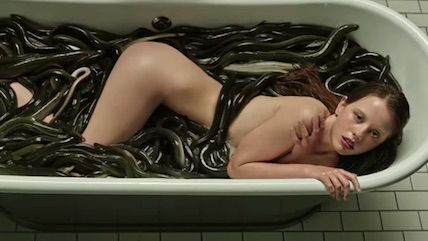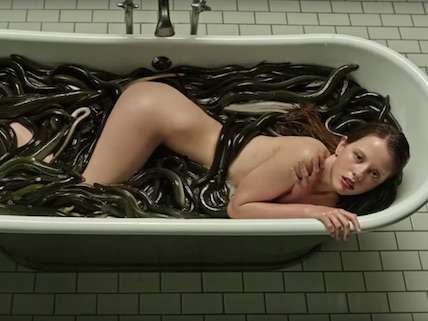Movie Review: A Cure for Wellness
Gore Verbinski goes blood-simple.


Gore Verbinski's A Cure for Wellness is a beautifully photographed nightmare that delivers powerful jolts of horror—some of them really horrific. But the movie doesn't make even basic fright-flicky sense, and the director doesn't seem to care. In the production notes, he invokes the term "dream logic" to justify the picture's endless narrative bafflements; but that's a handy out for a story that simply doesn't add up. So what's this lumbering oddity all about? I'm afraid it's about two and a half hours long.
Our protagonist is a young Wall Street hustler named Lockhart (talented but pasty Dane DeHaan, looking like Leonardo DiCaprio if Leonardo DiCaprio had been dragged behind a truck). In a long introductory passage that cries out to be trimmed, we learn that the company where Lockhart is employed is in turmoil and that its CEO, Pembroke, has lit out for a mysterious health spa in the Swiss Alps. A farewell letter he has left behind says, "I will not return. Do not attempt to contact me again." Lockhart is dispatched to find Pembroke and bring him back.
When Lockhart arrives in Switzerland, Verbinski, who still has a great eye, gives us a gorgeous shot of a gleaming train following a long curve of track into a mountain tunnel. Onboard, Lockhart notices a little boy drawing something in the condensation on a window. He's drawing the devil. How come? No reason—the devil makes no appearance in this movie. The kid's just setting a rote mood.
Verbinski seems to have been uncertain what he wanted to accomplish with this picture. It feels like a simple celebration of the horror tradition. Lockhart's mission to mountainous Mitteleuropa recalls Jonathan Harker's journey in Hammer's Horror of Dracula. And an overheard tale of incensed peasants faintly echoes the pitchfork-wielding mobs of various Frankenstein films. There are also trace elements of the gruesome Hostel movies, a brief dab of (ridiculous) zombie menace, and salutes to not one but two Vincent Price classics (The Abominable Dr. Phibes and the original House of Wax).
But there's nothing fond about these call-outs to generally much better movies, and after awhile I wondered if Verbinski was just going for a high-end gross-out movie. That's pretty much what he's ended up with—although even the movie's ickiness is vitiated by its constipated pacing.
Once he arrives at the castle-like spa and meets its director, the purring Dr. Volmer (Jason Isaacs), Lockhart has a chance to savor the air of heavy portent that hangs over the place. "There's a terrible darkness here," one patient whispers, unbidden. When he encounters a weird young woman named Hannah (Mia Goth) and expresses a desire to leave, she says, "No one ever leaves. Why would anyone want to?" As the minutes congeal into hours, we come up with our own answer to that question.
Lockhart now embarks on an obstacle course of bizarre torments. There's a hair-raisingly graphic dental ordeal, a gushingly gutted cow, a swimming pool full of eels, an isolation vat full of eels, a toilet full of eels—in fact, unless someone has made a full-length eel documentary, there are probably more of the slimy suckers here than in any other movie ever. If only we could figure out why. (All right, eels are kind of phallic, and when we see them in a pool swimming around the virginal Hannah, we get what Verbinski is trying to suggest. Unfortunately, it's not much—or anything, really. It's just something to gawp at.)
Basically, the spa's hydrotherapy regimen isn't curing any of its residents of whatever it is from which they suffer: it's actually making them sicker—unto death, in fact (or something like it: nothing's clear in this movie). And as Hannah has noted, none of them will be leaving. (Which raises a question: If nobody ever returns home from this place, how does word get around to attract new groups of well-heeled clients?)
Verbinski blows through at least two natural endings for the film, and presses on—and on, and on—until he reaches an incredibly gaudy scene of pedophiliac incest that's so off-putting you wonder who's supposed to be getting off on it. (All eyes on Verbinski, I'd say—he cooked up the story with scriptwriter Justin Haythe, also his henchman on the pitiful Lone Ranger.)
Apart from the movie's vibrant production design, and a sometimes haunting score by Benjamin Wallfisch, the best thing to be said about this elephantine enterprise is that it does, after what feels like days, actually end. How many viewers will stick around to be sure remains to be seen.

Show Comments (25)